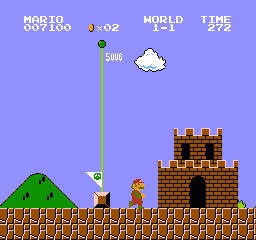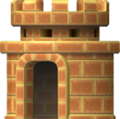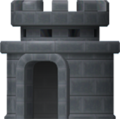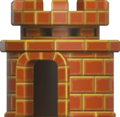Fortress
Fortresses, also known as forts, appear in the Super Mario franchise as fortified buildings appearing usually at the end of levels in the namesake series, behind Goal Poles, and are entered by Mario or Luigi after the level is cleared. Most games feature levels set inside fortresses.
History[edit]
Super Mario series[edit]
Super Mario Bros. / Super Mario Bros.: The Lost Levels[edit]
In Super Mario Bros. and Super Mario Bros.: The Lost Levels, fortresses are usually made from red bricks (except for the one at the very beginning of World 6-3 in the former game and World 7-3 in the latter game, which are colored gray like the rest of the level), and are usually located at the end of most levels, except for the third and fourth levels of each world, which end with a castle and take place inside that castle respectively. They also appear at the very beginning of underground and underwater levels, where Mario or Luigi enters the level via a Warp Pipe. Additionally, castles appear to be a fortress stacked upon a larger section. World 5-1 in Super Mario Bros. begins with Mario or Luigi outside a fortress, despite the level before taking place inside a castle; World 1-1 in The Lost Levels also begins in front of a fortress.
Super Mario Bros. 3[edit]
In Super Mario Bros. 3, fortresses, also known as Mini-Fortresses,[1] are levels usually found in the middle of worlds. They feature Boom Boom as their only boss, and he must be defeated to open Locked Doors[1] and gain access to other parts of the world.
In the Family Computer and Nintendo Entertainment System version, fortresses (barring World 2-![]() Fortress and World 6-
Fortress and World 6-![]() Fortress 2) can have any of three different color schemes:
Fortress 2) can have any of three different color schemes:
- Gray wall and red pipes. (P-Switches in this palette are colored light gray.) Lava is often found in areas with this palette.
- Cyan wall and white pipes. (P-Switches in this palette are colored light blue.) Areas with this palette sometimes have a checkered floor.
- Blue wall and green pipes. This palette is exclusive to the World 3 fortresses and can have water.
Some parts of some fortresses (all in Worlds 3, 5, 6, and 7) have light that usually has the same color as the pipes in whatever color scheme the appropriate part of the fortress uses. An exception is in the last interior room of World 5-![]() Tower, where the light is gray rather than white.
Tower, where the light is gray rather than white.
In Super Mario All-Stars and Super Mario Advance 4: Super Mario Bros. 3, the blue/green palette was taken out, with the affected fortresses using the blue/white palette instead. The cyan walls in the blue/white palette became darker blue. In addition, each fortress now has the same color scheme for all rooms, whereas in the NES original, rooms often alternated color schemes, most noticeable in World 8-![]() Fortress.
Fortress.
Super Mario World[edit]
In Super Mario World, fortresses are guarded by Reznors but are far less common, as there are only four in the game, and only one of them is mid-world. Fortresses are normally inaccessible after being completed, unless the player presses while holding
and
when at it on the map (does not apply to the Japanese version). The GBA version lets players re-enter fortresses freely after defeating Bowser; Dragon Coins have also been added to them. Like with castles, Yoshi cannot enter fortresses.
New Super Mario Bros. series[edit]
The end-of-level fortresses return in New Super Mario Bros., New Super Mario Bros. Wii, New Super Mario Bros. 2, and New Super Mario Bros. U and reprise their earlier role from the first Super Mario Bros. game, allowing the player to continue to the next level. Black fortresses appear as parts of secret exits, except in the original New Super Mario Bros. Their role from Super Mario Bros. 3 as mid-world levels is replaced by towers, which in New Super Mario Bros. Wii are called fortresses;[2] however, one of the Mario Vs. Luigi courses in the original New Super Mario Bros. is a fortress.[3]
Super Mario Galaxy 2[edit]
In Super Mario Galaxy 2, the Bowser Jr. levels at the end of Worlds 1, 3, and 5 are represented in the map as fortresses. However, only the first world's last level includes a fortress within it.
Super Mario 3D Land[edit]
Fortresses return in Super Mario 3D Land, but only in World 2-3 and Special 1-3, where they look as they did in Super Mario Bros. As in that game, they appear behind the levels' Goal Poles and can be entered, this time for a 1-Up Mushroom.
Super Mario Run[edit]
In Super Mario Run, courses do not end in Fortresses. In World Tour and Remix 10, castles that are not Bowser's Castle have fortress icons. Bowser's Fortress is a fortress replica that appears as a Kingdom Builder decoration.
Super Mario Maker series[edit]
In Super Mario Maker, its 3DS port, and Super Mario Maker 2, the castle theme in the Super Mario Bros. 3 style is based on the gray-wall color scheme of the fortresses from the original game. The fortresses of Super Mario Bros. and New Super Mario Bros. U return in the respective game styles.
Super Mario Bros. Wonder[edit]
In Super Mario Bros. Wonder, Castle Bowser turns some Poplin houses into fortresses with black domes and white horns in the game's intro, imprisoning the Poplins inside. They appear at the end of most levels and are turned back to normal when the player touches the Goal Pole.
Yoshi franchise[edit]
Forts also appear in the Yoshi franchise as the mini-boss levels of each world.
Paper Mario series[edit]
Paper Mario[edit]
In Paper Mario, the Goomba King's and Koopa Bros. Fortresses appear in the game.
Super Paper Mario[edit]
Super Paper Mario includes Fort Francis.
Paper Mario: Sticker Star[edit]
In Paper Mario: Sticker Star, Goomba Fortress appears.
Super Smash Bros. series[edit]
The Mushroom Kingdom stage in Super Smash Bros. Melee features a classic Super Mario Bros.-style fortress in the background. In Super Smash Bros. Brawl, Super Smash Bros. for Nintendo 3DS, and Super Smash Bros. Ultimate, one also appears in the Mushroomy Kingdom stage, in the same place as in World 1-1 of Super Mario Bros.; however, it is in the background, so fighters cannot enter it. It also appears in the Final Destination versions of the stage, as well as Ultimate's Battlefield version. Like the rest of the stage, it has a more realistic and withered appearance.
Mario Kart series[edit]
A Mii Racing Suit based on a fortress, known as the Castle Mii Racing Suit, was added to Mario Kart Tour during the 2022 Anniversary Tour. The suit returns in Mario Kart 8 Deluxe as one of the Mii Racing Suits added in Wave 6 of the Booster Course Pass DLC.
The Super Mario Bros. Movie[edit]
In The Super Mario Bros. Movie, a fortress can be seen in the background when Mario is transported to the Mushroom Kingdom. A restaurant in Brooklyn, named Castle Burger, is shaped similarly to a fortress from Super Mario Bros.
Appearances in other media[edit]
In Mario Ice Capades, during the whole show, King Koopa rode a moving fortress. A fortress also appeared in the background of the show as a prop. In The Super Mario Bros. Super Show!, a fortress appears only in the intro.
In Animal Crossing: Pocket Camp, the fortress as it appears in Super Mario Bros. could be obtained as special furniture in Fishing Tourney #12 (themed after the Super Mario franchise in celebration of Mario Day 2019), after passing the 4,900; 5,900; 7,100; 8,300; or 9,800 cm milestone.
Gallery[edit]
Super Mario Bros. Special (NEC PC-88)
Super Mario All-Stars (Super Mario Bros.)
Super Mario Maker (Super Mario Bros.-style, Ground theme)
Super Mario Maker 2 (Super Mario Bros.-style, Snow theme)
Names in other languages[edit]
| Language | Name | Meaning | Notes |
|---|---|---|---|
| Japanese | Toride |
Fort | |
| Dutch | Toren[?] | Tower | |
| French | Forteresse[?] | Fortress | |
| German | Bollwerke[?] | Stronghold | |
| Turm[?] | Tower | ||
| Italian | Fortezza[?] | Fortress | |
| Portuguese | Fortaleza[?] | Fortress | |
| Russian | Крепость[?] Krepost' |
Fortress | |
| Spanish | Fortaleza[?] | Fortress |
References[edit]
- ^ a b 1990. Super Mario Bros. 3 instruction booklet. Nintendo of America (American English). Page 22.
- ^ 2009. New Super Mario Bros. Wii instruction booklet. Nintendo of America (American English). Page 9.
- ^ Loe, Casey (May 15, 2006). New Super Mario Bros. Player's Guide. Nintendo of America (American English). ISBN 1-59812-009-3. Page 121.
- ^ 1988. スーパーマリオブラザーズ3 (Sūpā Mario Burazāzu Surī) instruction booklet. Nintendo (Japanese). Page 20.
- ^ Super Mario World Japanese instruction booklet (foldout)
- Fortresses
- Levels
- Super Mario Bros.
- Super Mario Bros. 3
- Super Mario Bros.: The Lost Levels
- Super Mario Bros. Wonder
- Super Mario World
- Super Mario World 2: Yoshi's Island
- Yoshi's Island: Super Mario Advance 3
- New Super Mario Bros.
- New Super Mario Bros. 2
- New Super Mario Bros. 2 levels
- New Super Mario Bros. U
- New Super Mario Bros. Wii


































